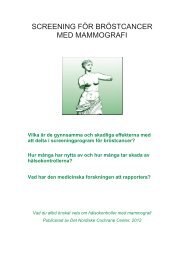1 Selective serotonin reuptake inhibitors (SSRI) â sales, withdrawal ...
1 Selective serotonin reuptake inhibitors (SSRI) â sales, withdrawal ...
1 Selective serotonin reuptake inhibitors (SSRI) â sales, withdrawal ...
Create successful ePaper yourself
Turn your PDF publications into a flip-book with our unique Google optimized e-Paper software.
902 Margrethe Nielsen et al.<br />
RESULTS<br />
Definitions<br />
In DSM-III, which was current in 1980 when benzodiazepines<br />
were recognized as being addictive, a diagnosis of<br />
dependence required either development of tolerance<br />
or <strong>withdrawal</strong> reactions (see Table 1 and Appendix S1;<br />
details of online supporting information are given at<br />
the end). Tolerance meant that increased amounts of<br />
the drug were required to achieve the desired effect.<br />
Withdrawal reactions meant a drug-specific syndrome<br />
following cessation or reduction in dose [16].<br />
There was a substantial change of the definition in<br />
the revised manual in 1987 (DSM-IIIR). Dependence was<br />
now described as a cluster of behavioural, cognitive<br />
and physiological phenomena [17]. Tolerance and <strong>withdrawal</strong><br />
reactions were among the manifestations, but<br />
they were no longer considered sufficient for the diagnosis<br />
(see Appendix S1 for details). Nine manifestation criteria<br />
were described (Table 1 and Appendix S1) and at least<br />
three of these should be fulfilled. A time criterion was<br />
also added, so that symptoms should have persisted for at<br />
least 1 month or should have occurred repeatedly over a<br />
longer time-period.<br />
In DSM-IV, published in 1994, the nine criteria were<br />
reduced to seven, three of which must be present and<br />
must have occurred in the same 12-month period [18].<br />
In ICD-10 from 1992, six criteria are described of<br />
which at least three must be fulfilled, occurring together<br />
for at least a month or repeatedly within a 12-month<br />
period [19].<br />
The DSM-IV sourcebook, which aims at presenting<br />
the empirical evidence and associated rationales for<br />
decisions in the DSM-IV diagnosis manual and the<br />
discussions related to the decision [21], was published<br />
immediately after the manual. Participants involved in<br />
the development of the DSM-IV authored the sourcebook.<br />
It appears from the DSM-IV sourcebook that the<br />
DSM-III revision of dependence was based mainly on the<br />
alcohol dependence syndrome, which was taken to also<br />
be valid for drugs. The sourcebook has a chapter about<br />
‘Psychoactive substance dependence’ and the reference<br />
list has 20 references to studies on such substances.<br />
However, 15 are to alcohol, three to opiates, one to narcotics<br />
and one to alcohol and opiates combined; there<br />
are no references to studies on psychoactive medicines.<br />
Concern was raised about the revised DSM-III definitions<br />
being so broad that other sorts of dependence could be<br />
included; for example, shopping dependence. Another<br />
important issue was that the diagnostic emphasis<br />
should again be placed on tolerance and <strong>withdrawal</strong><br />
reactions, i.e. the physical aspects of dependence. It was<br />
even recommended for future revisions of the DSM [21],<br />
but this did not happen.<br />
An important change from DSM-III to DSM-IV was<br />
that the phenomenon <strong>withdrawal</strong> reaction was listed not<br />
only as one of the criteria for dependence but also as an<br />
autonomous diagnosis at the same level as dependence.<br />
Withdrawal reactions are described in DSM-IV and<br />
ICD-10 as a group of symptoms of varying clustering and<br />
severity [18,19] (Table 2).<br />
Symptoms of <strong>withdrawal</strong> or dependence<br />
The literature search identified 4356 potentially relevant<br />
references about benzodiazepines and 562 about <strong>SSRI</strong>s.<br />
Of these, 45 and 31 relevant articles, respectively,<br />
Table 1 Definition of dependence in the classification systems DSM and ICD.<br />
Manifestation criteria<br />
Time criteria<br />
Number of<br />
manifestations required<br />
DSM-III (1980)<br />
DSM-IIIR (1987)<br />
ICD-10 (1992)<br />
DSM-IV (1994)<br />
Tolerance to the substance or <strong>withdrawal</strong><br />
symptoms<br />
Tolerance, <strong>withdrawal</strong> symptoms, much time<br />
spent to obtain the drug, not able to cut down<br />
use, uncontrolled use, continued use despite<br />
problems, normal activities are given up, the<br />
drug relieves <strong>withdrawal</strong> symptoms<br />
Tolerance, <strong>withdrawal</strong> symptoms, preoccupation<br />
with drug use, compulsion to take the drug,<br />
uncontrolled use, persistent use despite<br />
problems<br />
Tolerance, <strong>withdrawal</strong> symptoms, much time<br />
spent to obtain the drug, not able to cut down<br />
use, uncontrolled use, continued use despite<br />
problems, normal activities are given up<br />
No time criteria<br />
One month or manifestations<br />
have occurred repeatedly over<br />
a longer period<br />
One month or if less than a month<br />
then manifestations should have<br />
occurred together repeatedly<br />
within a 12-month period<br />
Manifestations occur at any time<br />
in the same 12-month period<br />
One<br />
At least three of the<br />
manifestations<br />
Three or more of the<br />
manifestations<br />
Three or more of the<br />
manifestations<br />
© 2011 The Authors, Addiction © 2011 Society for the Study of Addiction Addiction, 107, 900–908





